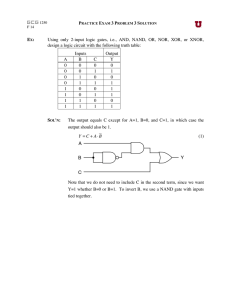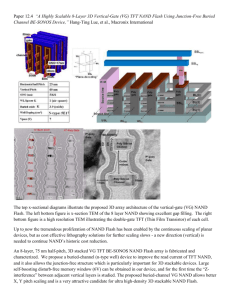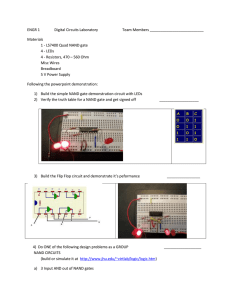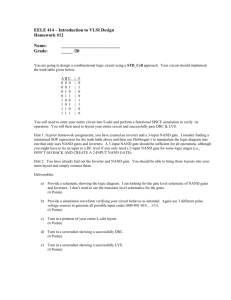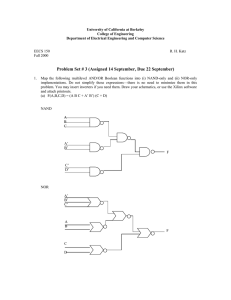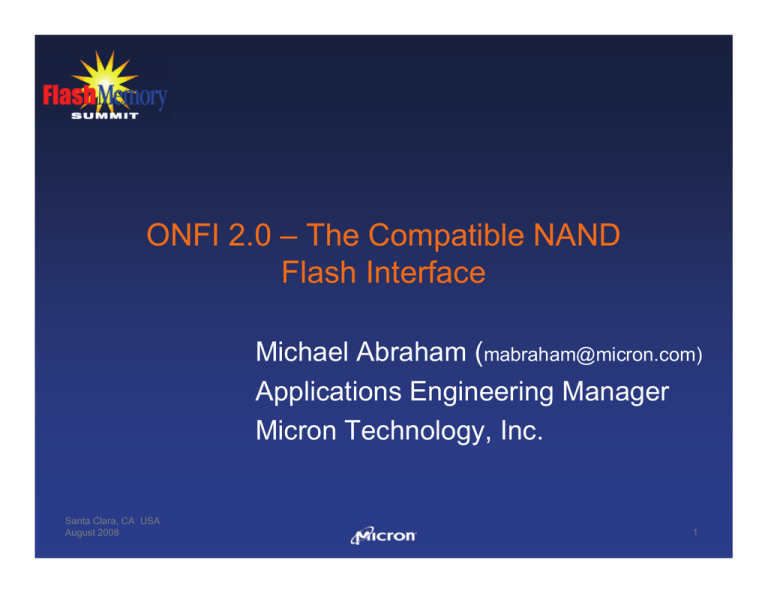
ONFI 2.0 – The Compatible NAND
Flash Interface
Michael Abraham (mabraham@micron.com)
Applications Engineering Manager
Micron Technology, Inc.
Santa Clara, CA USA
August 2008
1
Abstract
ONFI 1.0 standardized the asynchronous NAND Flash interface
with significant industry acceptance. It greatly simplified the
protocol, command set, and NAND signals providing a stable,
consistent interface on which to design controllers and reduce
compatibility testing.
ONFI 2.0 maintains backwards compatibility to ONFI 1.0 and
adds a faster, synchronous I/O interface to meet today’s
demanding high-performance needs. No alternative NAND
interface supports backwards protocol- and signaling-level
compatibility; it makes for an easy migration and upgrade path
for today’s high-performance controllers to support both source
synchronous and asynchronous NAND Flash. ONFI 2.0 is
publicly published (http://www.onfi.org/) and has the industry
support of over 80 member companies.
Santa Clara, CA USA
August 2008
2
The NAND Interface Today
ONFI 1.0 standardized today’s NAND
interface
• Consistent and easier for controller designers to
identify and use NAND features through use of the
parameter page
ONFI 1.0 introduced timing mode 5 for faster
I/O throughput
• New standard for NAND interface performance
• tRC / tWC = 20ns
Santa Clara, CA USA
August 2008
3
330MB/s
4 Gb Plane
NAND array reads are
parallel and very fast
• Read array bandwidth
is greater than
330MB/s (8KB read in 25us)
40MB/s
Page Buffer (4KB)
4 Gb Plane
Page Buffer (4KB)
Read Performance
Interface speed is the
limiting factor
• Read bus bandwidth is
40MB/s (25ns clock)
Total throughput after array read and I/O transfer is 34MB/s
Santa Clara, CA USA
August 2008
4
Single Channel I/O Bottleneck
(tR)
Total Read
Performance
8KB
25µs
211µs
34MB/s
8KB
50µs
211µs
30MB/s
Array Read
Planes
SLC 4KB
page
2
MLC 4KB
page
2
Device
Data Output
(tRC * Data
Cycles)
Data
Size
Read performance is I/O limited because tIO ≫ tR.
Santa Clara, CA USA
August 2008
5
I/O Throughput Cannot Scale
NAND Flash Interface is asynchronous
NAND timing parameters cannot scale indefinitely to
faster speeds
As tRC decreases, it becomes difficult for controllers to
latch data output from the NAND
As tWC for data input decreases, time to process
command and address cycles does not decrease
40% faster
50ns I/O
Santa Clara, CA USA
August 2008
17% faster
30ns I/O
25% faster
25ns I/O
20ns I/O
6
Goals of the ONFI 2.0 Source
Synchronous NAND Interface
Keep transition to high-speed interface simple
• Keep and/or redefine original NAND signals to provide high-speed
signaling without disrupting the NAND protocol and command set
• Provide backwards compatibility to asynchronous NAND interface to
make device identification simple
Increase I/O throughput with room to grow
• Remove tRC latching limitation by adding a bi-directional source
synchronous strobe (DQS)
• Remove tWC command and address cycle limitation by decoupling
command and address processing from the data input rate
Insure a graceful transition from the standard, asynchronous NAND
Flash interface to the source synchronous interface
Santa Clara, CA USA
August 2008
7
Scalable I/O Performance
A scalable interface is needed for more than read I/O
throughput
As more NAND devices are added to the bus even slower
MLC devices will max the I/O bus bandwidth
A fast NAND Flash interface is possible by:
• Adding bi-directional source synchronous DQS
• Providing scalable DDR data I/O interface
• Optimizing the signaling to allow enough time to
process command and address cycles
• Minimizing NAND pin capacitance
Santa Clara, CA USA
August 2008
8
ONFI 2.0 Source Sync Read Performance
4 Gb Plane
330MB/s
Shows significant
improvement for single-die
performance.
200MB/s
Shows significant gains for
multiple die on the same
channel.
4 Gb Plane
Device
Data
Planes Size
Data Output
(tR)
(tCK/2 * Data
Cycles)
Total Read
Performance
Array Read
SLC 4KB
page
2
8KB
25µs
43µs
120MB/s
MLC 4KB
page
Santa Clara, CA USA
2
8KB
50µs
43µs
88MB/s
August 2008
9
NAND Ö Source Sync NAND Interface
Asynchronous NAND Interface
Source Synchronous NAND Interface
CE#
NAND
DQS
CE#
ALE
ALE
CLE
CLE
RE#
NAND
W/R#
WE#
CLK
R/B#
R/B#
WP#
WP#
I/O[7:0]
DQ[7:0]
•
High-speed-capable NAND Flash devices power on using the asynchronous interface for backwards
compatibility
•
Set Features enables source synchronous interface
•
WE# becomes a fast CLK
•
RE# handles data direction by becoming W/R# (Write/Read#)
•
I/O[7:0] renamed to DQ[7:0] (name change only, functionally identical)
•
DQS, a new bi-directional signal, is enabled
Santa Clara, CA USA
August 2008
10
Source Synchronous Signal Description
Signals
Async
WE#
RE#
—
ALE / CLE
Santa Clara, CA USA
August 2008
Sync
CLK
Description
Free-running and used to latch command and address
cycles
During idle CLK may be stopped to save power
W/R#
Controls direction of DQ bus and DQS
• W/R# = “1”: Data input
• W/R# = “0”: Data output
DQS
During data phase, each DQS rising and falling edge
corresponds to a data byte
• DQS is center-aligned for data input
• DQS is edge-aligned for data output
ALE / CLE
For source synchronous mode:
• ALE / CLE = “11”: Data transfer
• ALE / CLE = “00”: Bus idle
11
Source Synchronous Page Read Example
Santa Clara, CA USA
August 2008
12
Low Power Signaling
As process geometry shrinks it becomes more difficult for controllers to stay with
3.3V I/O
•
•
Many applications today use 1.8V signaling
Many high-speed interfaces today use smaller voltage swings so signals can transition
faster
NAND Flash today requires the array and I/O to operate at the same voltage
•
•
Vcc = 2.7-3.6V, or
Vcc = 1.7-1.95V
NAND Flash array operations perform best when Vcc > 1.8V providing faster
Program, Read, and Erase times
By splitting the array voltage (Vcc) from the I/O voltage (VccQ) it is possible to
get fast array operations and faster, lower power I/O signaling
Potential high-speed voltage configurations
•
•
Vcc = 2.7-3.6V, VccQ = 2.7-3.6V
Vcc = 2.7-3.6V, VccQ = 1.7-1.95V
Santa Clara, CA USA
August 2008
13
High-Density Scalability
By providing multiple output drive strength settings many NAND
devices can share the I/O bus while maintaining I/O throughput.
Example: 133MT/s data throughput
Net result: Higher performance for fewer I/O channels
35-ohm driver, 4 NAND die
Santa Clara, CA USA
August 2008
25-ohm driver, 8 NAND die
18-ohm driver, 16 NAND die
14
Packaging
Source-synchronous-capable packages receive
• DQS signal
• Some Vcc change to VccQ
• Some Vss change to VssQ
The following packages have been transitioned
• 48-pin TSOP
• 63-ball BGA
Santa Clara, CA USA
August 2008
15
Introducing a New BGA Package
ONFI 2.0 introduced a new 100-ball BGA package
• Accommodates source synchronous and asynchronousonly NAND Flash devices
• Dual x8 interface
• More power/ground balls for lower noise
• Signals arranged for excellent signal integrity
• 1mm ball spacing for low-cost PCB assembly
• Accommodates ever-increasing NAND densities with two
package outline options
Santa Clara, CA USA
August 2008
16
ONFI 2.0 Summary
The source synchronous interface defined in ONFI 2.0 increases the bandwidth of each
I/O channel while adding only one pin, DQS.
The interface can scale up to 200MT/s in the first generation.
Designed for up to 16 die per I/O channel through use of output impedance control
The protocol is backwards compatible to asynchronous NAND reducing or eliminating
firmware changes for command set and device behavior
No DLL required in the NAND Flash devices
May necessitate a new high-speed PHY in controllers, but was designed to be similar
to mobile DRAM controller interface Æ evolutionary not revolutionary
Because ONFI 2.0 devices are backwards compatible with the asynchronous NAND
interface, controllers that only support the asynchronous interface can still use these
devices
Santa Clara, CA USA
August 2008
17
ONFI Connectors
ONFI defined a connector for
NAND modules
Form factors for small and larger
form factors
Modules support both
asynchronous-only and source
synchronous NAND Flash
devices
Santa Clara, CA USA
August 2008
Small Form Factor
Module & Connector
18
Members
ONFI membership climbs over 80!
Santa Clara, CA USA
August 2008
A-Data
Aleph One
Arasan Chip Systems
Avid Electronics
Chipsbank
DataIO
Entorian
Foxconn
Genesys Logic
Hitachi GST
Indilinx
ITE Tech
Lauron Technologies
Macronix
Metaram
NVidia
Powerchip Semi.
Qimonda
Shenzhen Netcom
Silicon Motion
Skymedi
Super Talent Electronics
Tanisys
Testmetrix
UCA Technology
WinBond
Afa Technologies
Anobit Tech.
ASMedia Technology
BitMicro
Cypress
Datalight
FCI
Fresco Logic
Hagiwara Sys-Com
Hyperstone
Inphi
Jinvani Systech
Lotes
Marvell
Moai Electronics
Orient Semiconductor
PQI
Sandforce
Sigmatel
Silicon Storage Tech
Smart Modular Tech.
Synopsys
Telechips
Transcend Information
University of York
Alcor Micro
Apacer
ATI
Biwin Technology
DataFab Systems
Denali
FormFactor
Fusion Media Tech
HiperSem
InCOMM
Intelliprop
Kingston Technology
LSI
Mentor Graphics
Molex
P.A. Semi
Prolific Technology
Seagate
Silicon Integrated Systems
STEC
Solid State System
Tandon
Teradyne, Inc.
Tyco
Virident Systems
19
ONFI Membership
Participation in ONFI provides opportunity to
review each draft of the specification
Membership open to all NAND vendors,
enablers, and OEMs
There are currently no dues
Download application at http://www.onfi.org
Santa Clara, CA USA
August 2008
20
For more information…
Open NAND Flash Interface
• ONFI 2.0 specification: http://www.onfi.org/
• ONFI 2.0 webinar: http://www.nand.com/
Micron High Speed NAND
• Product details: http://www.micron.com/highspeednand
• Marketing Brief:
http://download.micron.com/pdf/datasheets/flash/nand/8gb_nand_
mktg_brief_m51h.pdf
• The full product data sheet is also available (NDA required)
Micron’s NAND Webinars:
http://www.micron.com/products/nand/nand_webinars
Santa Clara, CA USA
August 2008
21
About Michael Abraham
Manager of Micron’s NAND Flash
Applications Engineering group
B.S. in Computer Engineering from
Brigham Young University
Micron’s technical representative
in ONFI and JEDEC for NAND Flash
Key role in defining and standardizing the new highspeed NAND interface within Micron and at ONFI
©2007-2008 Micron Technology, Inc. All rights reserved. Products are warranted only to meet Micron’s production data sheet specifications. Information, products
and/or specifications are subject to change without notice. All information is provided on an “AS IS” basis without warranties of any kind. Dates are estimates only.
Drawings not to scale. Micron and the Micron logo are trademarks of Micron Technology, Inc. All other trademarks are the property of their respective owners.
Santa Clara, CA USA
August 2008
22

